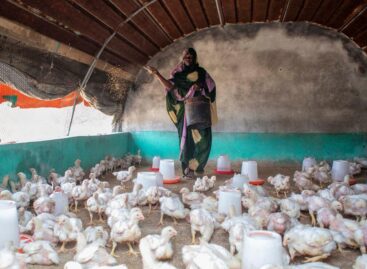OECD and FAO see slower growth in demand keeping world food prices low
Global food commodity prices are projected to remain low over the next decade compared to previous peaks, as demand growth in a number of emerging economies is expected to slow down and biofuel policies have a diminished impact on markets, according to the latest 10-year agricultural outlook published today by the OECD and FAO.
 The OECD-FAO Agricultural Outlook 2017-2026 says that the completed replenishment of cereal stocks by 230 million metric tonnes over the past decade, combined with abundant stocks of most other commodities, should also help limit growth in world prices, which are now almost back to their levels before the 2007-08 food price crisis.
The OECD-FAO Agricultural Outlook 2017-2026 says that the completed replenishment of cereal stocks by 230 million metric tonnes over the past decade, combined with abundant stocks of most other commodities, should also help limit growth in world prices, which are now almost back to their levels before the 2007-08 food price crisis.
The report foresees per capita demand for food staples remaining flat, except in least developed countries. Additional calories and protein consumption over the outlook period are expected to come mainly from vegetable oil, sugar and dairy products. Growth in demand for meat is projected to slow, with no new sources of demand projected to maintain the momentum previously generated by China.
By 2026, average calorie availability is projected to reach 2 450 kcal per person per day in least developed countries, and to exceed 3 000 kcal in other developing countries. Food insecurity and malnutrition in all its forms will nonetheless remain a persistent global problem, requiring a coordinated international approach, according to the report.
Future growth in crop production is projected to be principally attained through higher yields – 90 percent of the increase in maize production is expected to come from increased yields and just 10 percent from area expansion.
Growth in meat and dairy production, by contrast, is expected to come from both larger herds and higher output per-animal. Milk production growth will accelerate when compared to the previous decade, most notably in India and Pakistan. It is foreseen that aquaculture would dominate growth in the fish sector and farmed fish production will be the fastest-growing protein source among all commodities analysed in the Outlook.
The growth in agriculture and fish trade is projected to slow to about half the previous decade’s growth rate, and average less than 2 percent per year in volume terms for most commodities. Nevertheless, agricultural trade is expected to remain more resilient to economic downturns than trade in other sectors. For nearly all commodities, exports are projected to remain concentrated in a few supplying countries, which may imply a greater susceptibility of world markets to supply shocks.
“Real prices of most agricultural and fish commodities are expected to decline slightly over the ten-year Outlook period,” OECD Secretary-General Angel Gurría said at the launch event in Paris. “As we have seen in the past, unexpected events can easily take markets away from these central trends, so it is essential that governments continue joint efforts to provide stability to world food markets. It is equally important that we look ahead as we seek to meet the fundamental challenge facing world food and agriculture: to ensure access to safe, healthy, and nutritious food for a growing world population, while at the same time using natural resources more sustainably and making an effective contribution to mitigating climate change.”
“The report foresees that the average calorie availability per person per day will increase in least developed countries and in most emerging economies,” said FAO Director-General José Graziano da Silva. “But we also know that more food alone is not enough to eliminate undernourishment and other forms of malnutrition. Access to the additional calories is extremely important. More challenging is the fight against malnutrition: Fighting malnutrition requires a diversified, safe and nutritious diet, ideally produced with a lower environmental footprint.”
Related news
FAO: International food prices have been declining since September
🎧 Hallgasd a cikket: Lejátszás Szünet Folytatás Leállítás Nyelv: Auto…
Read more >FAO-Ministry of Agriculture Scholarship Program Continues
🎧 Hallgasd a cikket: Lejátszás Szünet Folytatás Leállítás Nyelv: Auto…
Read more >One of the Vice-Chairs of the OECD Competition Committee became the President of the Hungarian Competition Authority (GVH)
🎧 Hallgasd a cikket: Lejátszás Szünet Folytatás Leállítás Nyelv: Auto…
Read more >Related news
Crowds return to stores: margin cap and year-end preparations drive retail traffic
🎧 Hallgasd a cikket: Lejátszás Szünet Folytatás Leállítás Nyelv: Auto…
Read more >The second big rush in department stores comes between the two holidays
🎧 Hallgasd a cikket: Lejátszás Szünet Folytatás Leállítás Nyelv: Auto…
Read more >Pensioner food vouchers can be redeemed until December 31st
🎧 Hallgasd a cikket: Lejátszás Szünet Folytatás Leállítás Nyelv: Auto…
Read more >






